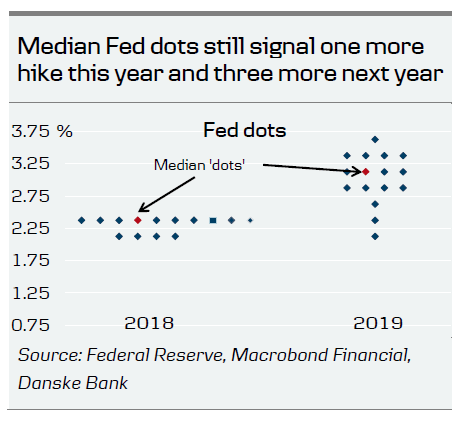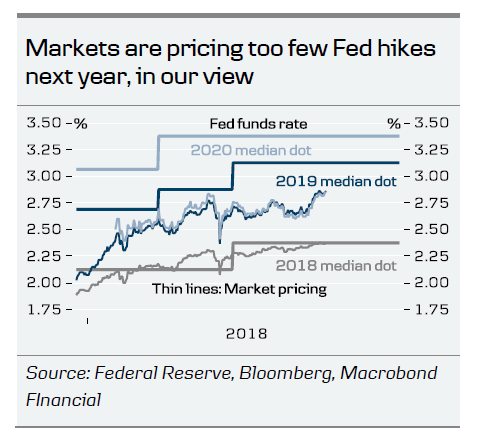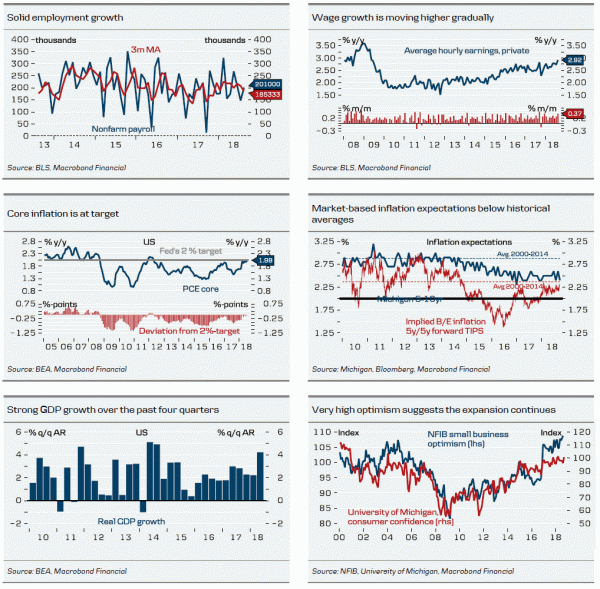Fed is on autopilot and the destination is neutral
The Fed meeting turned out pretty much in line with what we wrote in our FOMC preview: Destination neutral , as the Fed raised the target range by 25bp to 2.00-2.25% and did not send any new important signals to the markets, supporting our view that the Fed is on autopilot and neutral is the destination. We expect hikes in December, March and June are quite likely , which would take the Fed funds rate to 3.00%, which is the Fed’s long-run estimate of where monetary policy is neither expansionary nor contractionary (increased from 2.875% in the June projections, also not a big surprise).
The Fed chose to remove the sentence that “monetary policy is accommodative” from the statement, but in our view it does not matter much, as it just reflects reality, as the hiking cycle has been underway now for some time. The real economy is in good shape and is stronger than when the Fed started its tightening cycle : growth is strong, employment continues to rise, wage growth is increasing, PCE core inflation is 2% and optimism is high. The trade war has not had a material impact on the US economy so far, partly because the US economy is quite closed and partly because the substantial fiscal boost is offsetting the negative impact from trade.
As we argued in our preview, it is more ‘stop and go’ for the Fed when neutral is reached, as further hikes depend on how the economy is doing and how markets are reacting to monetary tightening. The median Fed dot signals that the Fed thinks it is appropriate to continue hiking and the upper end of the target range is set to peak at 3.50% in 2020. Seven FOMC members think that it is necessary to hike once more in 2020, which is one hawkish takeaway from the meeting.
We still believe that the Fed will hike four times from now until year-end 2019 (in December, in March, in June and one time in H2 19), which would bring the upper end of the target range to 3.125% by year-end 2019.
As expected, the market reaction was limited. We still see a case for both 2yr and 10yr US Treasury yields . The short-end is pushed higher, as our Fed rate path is not priced in the money market curve. The long-end is pushed higher by a modest increase in the US term premium and higher supply from the more expansive US fiscal policy, which boosts US bond supply. We forecast US 10yr yields in 12M at 3.25%. For more, see the latest issue of Yield Outlook , 17 September.
With the Fed set to stay on autopilot for now, US rates are set to stay a source of USD support. This should help cement the status of the dollar as a carry currency both in terms of the level of, and the change in, short-end yields. With the Fed still keen to continue the process of moving rates back towards ‘neutral’, it remains too early in our view for the FX market to price the Fed going on hold. This should help EUR/USD revisit the 1.15 area again during the course of the autumn . But, as the ECB is set to signal a first hike coming up at a time where the Fed could be looking to go on hold, a EUR/USD uptick should start to materialise.Indeed, it is when easing stops – rather than when hikes occur – that currency appreciation is seen, and vice versa.















